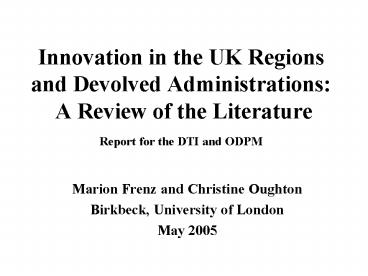Innovation in the UK Regions and Devolved Administrations: A Review of the Literature Report for the - PowerPoint PPT Presentation
1 / 24
Title:
Innovation in the UK Regions and Devolved Administrations: A Review of the Literature Report for the
Description:
Revival of regional innovation (from Marshallian industrial districts to ... Pecuniary. Agglomeration. Pools of skilled labour. Industrial atmosphere (R&D spillovers) ... – PowerPoint PPT presentation
Number of Views:92
Avg rating:3.0/5.0
Title: Innovation in the UK Regions and Devolved Administrations: A Review of the Literature Report for the
1
Innovation in the UK Regions and Devolved
Administrations A Review of the
LiteratureReport for the DTI and ODPM
- Marion Frenz and Christine Oughton
- Birkbeck, University of London
- May 2005
2
Regional Innovation Background and Context
- Growth in innovation studies since 1960
- Revival of regional innovation (from Marshallian
industrial districts to clusters, to the new
economic geography) - Link between innovation and growth, productivity
- Closing the regional productivity gap an
important part of closing the UKs productivity
gap
3
Innovation and Economic Performance
- Performance variables growth, productivity
growth, GDP per capita, GDP per worker - RD heavily concentrated in 2 regions (South
East and Eastern)
4
Figure 2.1 Business expenditure on RD in 2002
million
5
Figure 2.2 Government expenditure on RD in 2002,
million
6
Figure 2.3 Higher education expenditure on RD in
2002, million
7
Figure 2.5 Growth rates in per capita GERD
8
Table 2.1 Business RD Expenditure per employee
CIS and ONS data
9
Table 2.3 Analysis of variance in RD intensity,
innovation activity and living standards across
178 regions and 12 nations of the European Union,
1999
10
Table 2.4 Matrix of correlation coefficients for
indicators of innovation activity, RD intensity
and competitiveness
11
The Community Innovation Survey
- There is variation in product innovation across
UK regions, notwithstanding - That CIS provides a broad measure of innovation,
capturing diffusion as well as novel innovation - The measure does not capture the extent of
innovation - Innovation and RD are concentrated in a
relatively small number of firms - Greater regional variation in new-to-market
innovations - South East and Eastern regions exhibit higher
proportions of novel innovators
12
Percentage of product innovators and novel
product innovators
13
Percentage of enterprises introducing
organizational changes
14
Percentage of enterprises that had co-operation
arrangements
15
Average number of employees per enterprise that
hold a degree
16
Theoretical Evidence
- Neoclassical approach
- Firm based
- Technology is exogenous (more recent models are
endogenous) - Growth accounting
- TFP
- Innovation is a residual and not explained
17
Theoretical Evidence II
- Marshallian externalities
- Pecuniary
- Agglomeration
- Pools of skilled labour
- Industrial atmosphere (RD spillovers)
- Geography of innovation
- Tacit and codified knowledge
- Systems of innovation
- National systems (Freeman, 1987)
- Regional Systems (Cooke, Howells)
- Learning regions
18
Empirical Evidence
- Growth accounting models
- Regional disparities in TFP
- These persist even when RD is included
- Key explanatory variable of regional TFP stock
of human capital - Geography of Innovation
- Spillover effects are
- positive within regions (intra-regional)
- decay across distance
- positive across regions (inter-regional) but
smaller than intra-regional effects - Positive role of (regional) public sector RD
19
Empirical Evidence II
- Systems of innovation
- How does knowledge spillover?
- inter-firm cooperation (innovation)
- business-firm cooperation (novel innovation)
- mobility of star researchers
- If business-firm cooperation increases
innovation, why is there so little of it? - absorptive capacity
20
Empirical Evidence III
- Role of multinationals and openness of regions
- Multinationals attracted by
- infrastructure
- strength of science base
- skilled labour
- industry specialisation (agglomeration economies)
21
Empirical Evidence IV Governance and Institutions
- Study of 17 OECD countries, 1980-2000
- Looks at convergence in living standards and
productivity - Finds strong positive relationship between
decentralisation and regional equality - Fiscal decentralisation has biggest impact
22
Empirical Evidence V Case Studies
- Descriptive - snap shot
- Historical stages of development
- Agglomeration economies
- Role of the public sector (research and skilled
labour) - Long lead times
- Availability of venture capital
- Collective external economies (networks)
- Political commitment
- Real time case studies
23
Future Research
- how each of the different types of external
economies promotes innovation and growth - the necessary and sufficient conditions for each
type of externality to be realised - how the different types of external economies
interact - the extent and range of spillover effects
- the stages of development of a locality and the
relative importance of different types of
externalities at each stage
24
Future Research II
- the processes of cumulative causation
- the mechanisms via which knowledge spills over
from one organisation/firm to another, for
example, bi-lateral cooperative agreements,
formal network agreements, informal networks,
movement of skilled labour, spin-offs, an
atmosphere of innovation, accidental spillovers - the role of absorptive capacity, human capital,
skills and managerial capability - organisational innovation and
- institutions, social capital and governance.































